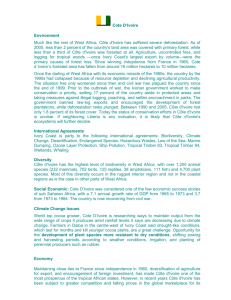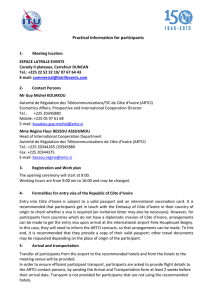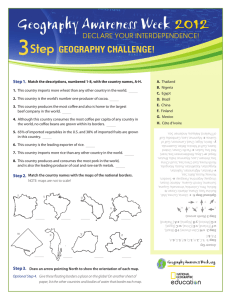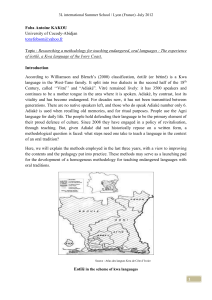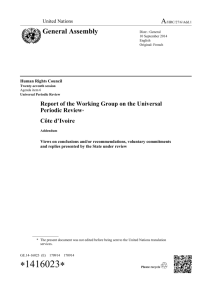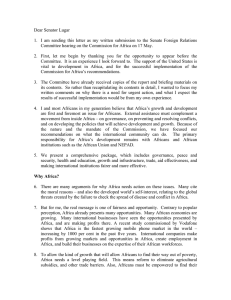The Impacts of Cote d’Ivoire’s Urbanization on its Economy and Populace
advertisement
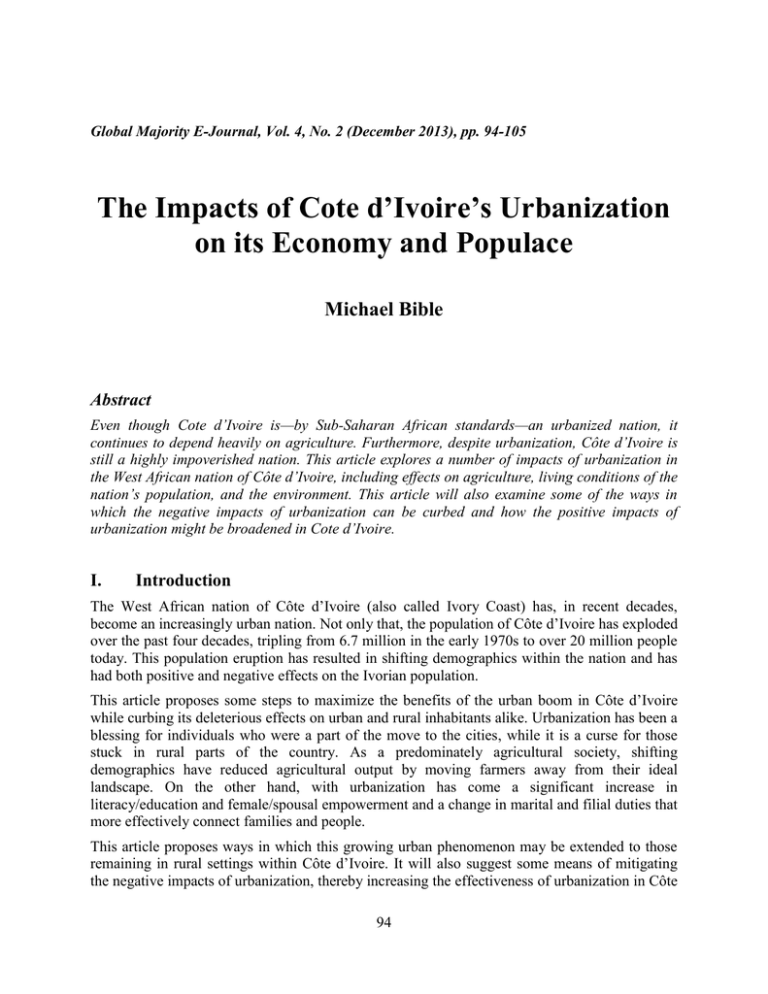
Global Majority E-Journal, Vol. 4, No. 2 (December 2013), pp. 94-105 The Impacts of Cote d’Ivoire’s Urbanization on its Economy and Populace Michael Bible Abstract Even though Cote d’Ivoire is—by Sub-Saharan African standards—an urbanized nation, it continues to depend heavily on agriculture. Furthermore, despite urbanization, Côte d’Ivoire is still a highly impoverished nation. This article explores a number of impacts of urbanization in the West African nation of Côte d’Ivoire, including effects on agriculture, living conditions of the nation’s population, and the environment. This article will also examine some of the ways in which the negative impacts of urbanization can be curbed and how the positive impacts of urbanization might be broadened in Cote d’Ivoire. I. Introduction The West African nation of Côte d’Ivoire (also called Ivory Coast) has, in recent decades, become an increasingly urban nation. Not only that, the population of Côte d’Ivoire has exploded over the past four decades, tripling from 6.7 million in the early 1970s to over 20 million people today. This population eruption has resulted in shifting demographics within the nation and has had both positive and negative effects on the Ivorian population. This article proposes some steps to maximize the benefits of the urban boom in Côte d’Ivoire while curbing its deleterious effects on urban and rural inhabitants alike. Urbanization has been a blessing for individuals who were a part of the move to the cities, while it is a curse for those stuck in rural parts of the country. As a predominately agricultural society, shifting demographics have reduced agricultural output by moving farmers away from their ideal landscape. On the other hand, with urbanization has come a significant increase in literacy/education and female/spousal empowerment and a change in marital and filial duties that more effectively connect families and people. This article proposes ways in which this growing urban phenomenon may be extended to those remaining in rural settings within Côte d’Ivoire. It will also suggest some means of mitigating the negative impacts of urbanization, thereby increasing the effectiveness of urbanization in Côte 94 d’Ivoire and preserving the old way of life and its contributions to the nation (i.e., the cocoa trade). This article will also emphasize the need for increased education and awareness to prevent the negative impacts of urbanization such as pollution, sanitation issues, unemployment, agricultural downturn and issues of water availability. II. Literature Review There are a number of sources that provide quite a bit of insight into the positive and negative effects of urbanization in Côte d’Ivoire. The following three sources discuss a number of social, and to some extent economic, developments resulting from Côte d’Ivoire’s urbanization. One of the earliest publications on Côte d’Ivoire’s urbanization is an article by Remi Clignet (1966). Clignet explores the way in which urbanization has worked to affect social change, particularly in regard to family structure. By examining the familial relationships of both rural and urban sects of the same ethnic groups, the Aboure and Bete peoples, Clignet draws a number of conclusions about the way in which urbanization has served to shape family structures in Côte d’Ivoire. Some noteworthy features of her article include explorations of the empowerment of women, changing marital expectations (ages, male versus female obligations, ethnic partner choice, etc.), impacts on children, and increased literacy rates that have all resulted from urbanization in Côte d’Ivoire. She concludes that Côte d’Ivoire’s urbanization (as it happened before 1965) eroded ethnic differentials in some patterns of behavior. Obrist, Cissé, Koné, Dongo, Granado, and Tanner (2006) published an article in the European Journal of Development Research entitled “Interconnected Slums: Water, Sanitation and Health in Abidjan, Côte d’Ivoire” in which they discuss the interconnectedness of urban areas and the way in which urbanization, particularly within slums and quartiers précaires, has affected the livelihoods of individuals living in these, and surrounding, areas. This article places particular emphasis on Abidjan, the capital and commercial center of Côte d’Ivoire.1 The authors are interested in presenting the results of a number of in-depth studies done in this region regarding the state of water provision, sanitation, health care, and environmental impacts on the urban population (in slums). The article concludes with the idea that understanding slums as a structural phenomenon of urbanization, requires examining them as entities separate from the city itself. Potts (2009) published an article entitled “The Slowing of Sub-Saharan Africa’s Urbanization: Evidence and Implications for Urban Livelihood” in the journal Environment and Urbanization. She explores the state of urbanization in a number of sub-Saharan African countries, including Côte d’Ivoire. Her article includes a number of tables detailing specific quantifiable aspects of urbanization within this region of Africa. An important implication of this article is that, while urban fertility is falling in Côte d’Ivoire, death rates are falling, and hence, countering the effects of fertility drops. Potts also observes significant differences in infant and child mortality rates between rural and urban populations. 1 Within Abidjan, the municipality of Yopougon is the focus of the study; a municipality consisting of ten settlements (six slums, a middle-class neighborhood, and three villages in the peri-urban area surrounding the city. 95 III. Empirical Background III.1. Political Turmoil in Côte d’Ivoire Since 1980, Côte d’Ivoire has experienced quite a bit of political unrest. Its president from 19601993, Houphouet-Boigny served seven fairly uncontested terms before his death though there were two unsuccessful coup attempts in 1963 and 1973. However, 1990 was the first year in which a multiparty election was held and the presidency was contested by Laurent Gbagbo who lost despite an appeal to the Supreme Court. Houphouet-Boigny was succeeded by Henri Konan Bédié, a member of his ethnic and political group. The following election in 1995 assured his continued presidency though the polls were mostly boycotted by the opposition. Under Bédié’s presidency, attempts were made to exclude certain challengers from running for the presidency based on their ethnic identification. Tensions escalated greatly and in December of 1993, soldiers mutinied and Brigadier General Robert Guei took control of the country. The October 2000 election pitted Guei against Gbagbo who was, after significant controversy, named president. In 2010 there was more controversy over the presidency when Gbagbo refused to step down despite losing the election. For nearly half a year, the nation teeter-tottered on the brink of civil war, something the country is not unfamiliar with. Gbagbo was arrested and Alassane Ouattara now holds the Ivorian presidency.2 Early in Gbagbo’s presidency (September 2002), a failed coup ignited a civil war, pitting the government-controlled south against the rebel-held north. Intervention from France, the UN and the Economic Community of West African States created a buffer zone that slowed the fighting. Despite reaching peace agreements in January of 2003, the issues that had divided the country including land ownership, qualifications for holding office, and the basis for nationality, were never completely resolved and tensions exploded in late 2004 when the government, in violation of the cease-fire agreement, bombed rebel-held areas in the northern part of the country. An official cease-fire was finally established in April of 2005 though fighting continued, thus forcing elections scheduled for that year to be called off. Finally in 2007 and agreement was reached that allowed for Gbagbo’s continued presidency with the post of prime minister given to the rebel leader Guillaume Soro. 3 III.2. Economic and Social Development The population of Côte d’Ivoire has grown substantially in recent years – more than tripling from 6.7 million to over 22 million people in the span of less than 40 years. Côte d’Ivoire is the fifteenth most populous country in Africa with approximately 22 million people. According to the International Monetary Fund (2012) , Côte d’Ivoire ranks 161st amongst the world’s nations in terms of purchasing power parity-adjusted GDP per capita. The chart below shows the progression of Côte d’Ivoire’s GDP per capita over the period 1980-2010. Over that period of time, Côte d’Ivoire’s GDP per capita has fallen from $2,620 in 1980 to $1,704 in 2010, despite increased urbanization. On the other hand, developing countries as a whole in sub-Saharan Africa (SSA) have seen increased GDP per capita in the past decade, overtaking that of Côte d’Ivoire in 2004. Furthermore, income is highly uneven distributed in Côte d’Ivoire, with the top ten percent of the population accounting for more than 30 percent of Côte d’Ivoire’s total income (World Bank, 2012). 2 3 See Comhaire (2012). See Comhaire (2012). 96 Figure 1: GDP per capita, PPP (constant 2005 international $) in Côte d’Ivoire and the Average Developing Country of Sub-Saharan Africa (SSA), 1980-2010 Source: Created by author based on World Bank (2012). Côte d’Ivoire is the world’s largest exporter of cocoa. Côte d’Ivoire accounts for 40 percent of total GDP in the West African Economic and Monetary Union (WAEMU) and is therefore the region’s largest economy. Cocoa is Côte d’Ivoire’s major export/product and it’s interesting to consider this agricultural industry given that a shift towards a more urban country would seemingly reduce the agricultural labor force. Despite this fact, it is worth noting that the cocoa industry has proven highly resilient despite the country’s many economic downturns that have resulted from civil war, coup d’états, and other periods of social and political turmoil. While very little quantitative data on literacy rates is publicly available for Côte d’Ivoire, the few years with recorded literacy rates indicate an upward trend for both adults and youths in the country. Compared with those of developing countries of SSA as a whole, however, the literacy rates of both groups in Côte d’Ivoire have been consistently lower. Neither the region nor Côte d’Ivoire has a particularly high literacy rate; even now, literacy rates are below three quarters of the population in both Côte d’Ivoire and the developing countries of SSA (see figures 2 and 3 below). In studies of different ethnic groups within Côte d’Ivoire who have moved from rural to urban areas, Clignet (1966) found increased literacy rates in children who had moved to the city. Though the study is somewhat dated, these results suggest a positive correlation between urbanization and literacy rates in Côte d’Ivoire. With over fifty percent of the nation’s population living in cities, it is no wonder that there is increased access to education. According to Charlick (1978, p. 191), a large portion of educational opportunities within Côte d’Ivoire are, and traditionally have been, concentrated in the urban southeast, particularly Abidjan. This indicates a positive relationship between proximity to urban centers and literacy rates observable from figures 2 and 5. 97 Figure 2: Literacy Rates in Côte d’Ivoire, 1988-2009 Source: Created by author based on World Bank (2012). Figure 3: Literacy Rates in Developing Countries of SSA, 1990-2009 Source: Created by author based on World Bank (2012). Life expectancy at birth in Côte d’Ivoire has increased by eleven years over the past forty years. This increase in life expectancy has also coincided with increased life expectancy throughout the region. As figure 4 demonstrates, life expectancy in Côte d’Ivoire has grown from 44 years in 1970 to 53 years in 1987, after which it declined to 50 years in 2000 (largely due to HIV/AIDS), 98 and then increased once again until 55 year in 2010. Figure 4 also shows that life expectancy in developing SSA was below that of Côte d’Ivoire until 2003, but slightly overtook Côte d’Ivoire’s life expectancy from 2003 to 2008, when Côte d’Ivoire caught up. Figure 4: Life Expectancy in Côte d’Ivoire and Developing SSA, 1970-2010 Source: Created by author based on World Bank (2012). Potts (2009) makes note of the fact that, in addition to increased life expectancy, urban populations enjoy a certain degree of decreased infant and child mortality, providing for a more youthful urban population. In general, urbanization is understood to be an increase in the urban share of a country’s population. In Côte d’Ivoire, the urban share of the population recently surpassed fifty percent and over the past few decades has grown substantially. Côte d’Ivoire is actually considered an urbanized country by sub-Saharan African standards. Generally, the gross domestic product in purchasing power parity per capita has had an observable upward trend that could perhaps be correlated to the increasing urbanization of Côte d’Ivoire. There has also been an increase in literacy rates amongst adults in Côte d’Ivoire over the past twenty years that is very probably related to increasing urbanization in the country. IV. Urbanization’s Effects on Côte d’Ivoire Much like any other nation experiencing urbanization, Côte d’Ivoire and its inhabitants have experienced significant positive and negative outcomes from urbanization. While urbanization brings people together and makes goods and services more accessible, it also creates issues that stem from overcrowding and high density population zones. This section will thus explore some of the positive and negative implications of urbanization specific to Côte d’Ivoire. In particular, this section is concerned with identifying problems that need to be remedied and things that are being done well that need to be extended. 99 IV.1. Côte d’Ivoire’s Urban Population Growth Côte d’Ivoire has a total population of approximately 22 million people and, as of 2010, 50.1 percent of its population live in an urban setting. This is the first year in the country’s history in which the number of people living in cities exceeded the number of people living in rural areas. As figure 5 shows, the urban percentage of the population of Côte d’Ivoire has increased fairly consistently over the past forty years while the rural percentage of the population has consistently declined in the same period of time. Of Côte d’Ivoire’s 42 cities, only one (Abidjan) has a population that exceeds one million people, and only four have populations that exceed two hundred thousand inhabitants. Most of the country’s cities are rather small. Figure 5: Percentage of Population Living in Urban and Rural Settings in Côte d’Ivoire, 1970-2010 Source: Created by author based on World Bank (2012). IV.2. Decline in the Value Added by Agriculture With a decrease in the percentage of individuals living in rural areas due to the urbanization that has occurred in Côte d’Ivoire, it is to be expected that one should find a decrease in the importance of agriculture as a source of the nation’s industry. This makes sense in that a decrease in the percentage of the population living in rural areas and working in agriculture – on cocoa farms for instance – would result in lower yield or these products would be a smaller share of a larger economy with new bases in cities/ urbanized areas. As figure 6 demonstrates, the value added to the national economy by agriculture has been on a clear decline in the past few decades (World Bank, 2012). This does not necessarily mean that agriculture is any less important for the economy of Côte d’Ivoire; it may just mean that there is more industry in cities contributing to the national economy. Urbanization has certainly impacted the agricultural industry in Côte d’Ivoire. 100 Figure 6: Value Added by Agriculture (as percent of GDP), 1970-2010 Source: Created by author based on World Bank (2012). In a recent article entitled “Urbanization without Structural Transformation: Evidence from SubSaharan Africa”, Gollin, Jedwab and Vollrath (2012) observe that while most nations that have undergone urbanization have also experienced structural transformation within that nation’s society, urbanization within African countries, including Côte d’Ivoire, seems to behave contrary to this trend. They observe that often times African urbanization has not been accompanied by new industry or infrastructural improvements. Their research suggests that, while other countries that experience urbanization do so while undergoing either an industrial revolution or green revolution, Africa has followed a different pattern. They call the movement accompanying African urbanization a Natural Resource Revolution. This helps to explain why there has been so much urbanization in Côte d’Ivoire but very little growth of industry or agriculture. While Africa is endowed with immense natural resource wealth, it also has a strong comparative advantage in the production of a number of non-food crops, including cocoa, Côte d’Ivoire’s largest export. African nations have an unfortunate tendency to simply export raw resources rather than refining them to higher-value outputs. This means that Urbanization occurs in such a way as to provide for easier export of goods; however, it does not provide for a skilled labor force. According to Gollin et al. (2012), urbanization in Côte d’Ivoire was driven by the cocoa booms that characterized the 1960s, 1970s, and 1980s. During this period, the percentage of people living in urban environments in Côte d’Ivoire more than doubled from 18 percent in 1960 to 41 percent in 1990. This is perhaps the greatest shift in population concentration that Côte d’Ivoire has yet seen. The peaks of the curve shown in Figure 6 can thus be explained by the cocoa booms experienced during the aforementioned period. The relative constancy of the trend-line after 1994 suggests that that time in the history of Côte d’Ivoire was not characterized by the same degree of cocoa production as it was earlier. Figure 6 also indicates that the value of agriculture to the nation has fluctuated around 30 percent for many years suggesting that it is actually a fairly important, and large, part of the Ivorian economy as suggested by the nation’s reliance on cocoa. Ultimately, the 101 nation relies most heavily on agriculture – whether cocoa, coffee, or palm oil – and statistically speaking, urban households are poorer as a result of this lack of industry. Given that urbanization in Côte d’Ivoire occurred to a large extent during booms to the cocoa industry, it was necessarily associated with cities that provided export friendly locations. It is, therefore, worth noting that most urbanization in Côte d’Ivoire has occurred in coastal cities or cities near borders that allow for trade. Abidjan, for instance, is the nation’s largest city and it is located in the coastal region of Côte d’Ivoire with easy access to the trade-friendly waters of the South Atlantic. IV.3. Use of Electricity In the span of about forty years, according to World Bank, electrical consumption per capita has increased more than twofold. In 1971 Côte d’Ivoire used around 91 kWh of electricity per capita and in 2009 it used about 203 kWh per capita (see figure 7). This increase in electricity usage coincides with the increased urban population observable in figure 5. It makes sense that an urbanized state should use more electricity than a predominately rural state and therefore it is easy to see where this increased usage comes from. Figure 7: Electric Power Consumption in Côte d’Ivoire, 1971-2009 Source: Created by author based on World Bank (2012). In recent years, the Ivorian government has taken interest in implementing activities and projects designed to upgrade urban living areas. This has occurred to a large extent in Abidjan in recent years with attempts to improve primary infrastructure (roads, water, and electricity) set in motion over the past forty years. In fact, the World Bank has supported five different projects in Côte d’Ivoire aimed at urban development; the Second Urban Project was aimed at improving the infrastructure of Abidjan between 1981 and 1987. Other projects were implemented in other large urban centers in Côte d’Ivoire such as the city of Man. Agencies such as the World Bank, the Côte d’Ivoire’s Urban Development Directorate, and Côte d’Ivoire’s Department for Urban Upgrading have worked to significantly improve infrastructure in many of the most populous 102 municipalities (World Bank, 2002). These improvements to urban living conditions, particularly in the expanded availability of electricity to the populace began in the mid-1970s and have continued into the new millennium. It can, therefore, be concluded that to a large degree, the increased electricity use identified in figure 7 has stemmed from improved infrastructure in urban Côte d’Ivoire. IV.4. Increasing Carbon Dioxide (CO2) Emissions and other Environmental Issues While CO2 emissions are not typical of agriculture, they are very typical of industrial production. Heightened CO2 emissions are also indicative of an urbanized state in that industry and other carbon dioxide producing activities concentrate in urban centers. It is clear in comparing figures 5 and 8 that there is a correlation between urbanization and the carbon dioxide emission of Côte d’Ivoire. It can be assumed that the increasing carbon footprint of Côte d’Ivoire has resulted from the increase in industry, vehicular transportation, and fuel/power use associated with urban centers. Figure 8: Carbon Dioxide Emissions in Côte d’Ivoire, 1970-2008 Source: Created by author based on World Bank (2012). In recent studies conducted in Abidjan, Obrist et al. (2006) found that the interconnectedness of the wealthier and more impoverished areas has dramatically impacted the environments of both areas. In one of the municipalities studied by this group, they found that a substantial proportion of the population of Abidjan was living on over seventy settlements on illegal or non-residential land. These settlements, designated quartiers précaires, were hazardous areas but the government has shown little interest in intervention. The slums of Abidjan are located right next to approved, safe, “modern” housing and the uncleanliness of the slum environment has an impact on these surrounding regions. Some of the most significant environmental hazards emerge from the wastewater generated by the slums of Abidjan. Even settlements miles from the city feel the impact of poor waste 103 management. Waterways carry wastewater and garbage from the city to rural populations who suffer from the contaminants. There is little understanding of the impact that individuals have on their environment and, therefore, they perpetually dispose of waste in an irresponsible manner. Not only are populations outside of the city affected by this poor management of humangenerated waste but also other sections of the city population suffer on account of poor means of disposal. Drainage channels in particular pose the greatest threat to the environment in that for years they have served as an irresponsible means of disposing of waste. Open drainage channels throughout the city are heaped with human waste and other garbage creating a noxious smell and severe health hazards. In fact, the Ebrié Lagoon, just outside of Abidjan has been overwhelmed by pollutants though recent efforts have been put in place to recover its natural purity. The great majority of this poor waste management stems from the fact that so many city-dwellers actually live in illegal slums in hazardous locations. More government intervention is needed to curb these unhealthy settlements and increase the availability of real homes within the city. V. Conclusion While urbanization in Côte d’Ivoire has been shown to be linked to increased life expectancy and higher literacy rates amongst the population of urban areas, there are also negative implications inherent to the idea of urbanization. It is true that Côte d’Ivoire is a predominately agricultural society and that a major reason for urbanization in the country was the cocoa boom. This, unfortunately, hardly improves anyone’s condition within the nation. I feel that the government of Côte d’Ivoire should discourage simply exporting goods but should encourage the refinement of those goods within the nation. This would create jobs, increase the income from exports, and would help to truly industrialize the nation’s urban centers. It is also possible, given that a green revolution has yet to occur in Côte d’Ivoire, the government should encourage more productive means of harvesting goods (coffee, cocoa, palm oil) so as to increase profitability from exports. These are two simple ways in which the population of Côte d’Ivoire might escape the negative effects of the natural resource revolution occurring there. Pollution is another major policy issue that needs to be addressed in urban areas. Urban living conditions need to be improved so that hundreds of thousands are not living in hazardous slums. This means that the government ought to institute greater waste education throughout the population and needs to create a more dedicated waste management organization prepared to handle sanitation issues within cities and their outskirts. The government must also lose its apathy towards illegal home locations, thereby curbing the creation of unsafe slum areas in the first place. It is important that policy makers ensure that the safety of city-dwellers is a higher priority by increasing the availability of more modern homes made of safer materials. It is important that the environment be taken care of so as to prevent serious health hazards and to ensure the continued availability of safe water. It must be made clear to the public that contaminating water supplies is simply unacceptable. These are only a few, very simple steps that can be taken to curb the negative effects of urbanization. Urbanization presents a unique opportunity and challenge to policy-makers and a country’s population. On the one hand, there are significant benefits to urbanization (i.e. increased life expectancy, increased education, and increased access to infrastructure) but on the other, there are a number of negative consequences (health hazards, pollution, increased poverty). Ultimately, it is up to the government of Côte d’Ivoire to continue efforts to make its urbanization a more beneficial experience. Projects to increase infrastructure must remain a 104 priority, and educating the public and preventing environmental damage must become a greater concern if Côte d’Ivoire is to be a more successful nation in the modern world. References Charlick, Robert B. (1978). Access to “Elite” Education in the Ivory Coast--The Importance of Socio-Economic Origins. Sociology of Education, Vol. 51, No. 3, pp. 187-200. Clignet, Remi (1966). Urbanization and Family Structure in the Ivory Coast. Comparative Studies in Society and History, Vol. 8, No. (4), pp. 385-401. Comhaire, Jean L. (2012). Côte d’Ivoire. Encyclopedia Britannica; retrieved from http://www.britannica.com/EBchecked/topic/139651/Cote-dIvoire. Gollin, Douglas; Remi Jedwab; and Dietrich Vollrath (2012). Urbanization without Structural Transformation: Evidence from Sub-Saharan Africa. mimeo; available at: https://editorialexpress.com/cgi-bin/conference/download.cgi?db_name=CSAE2013&paper_id=351. International Monetary Fund (2012). World Economic Outlook Database October 2012 (Washington, DC: International Monetary Fund); available at: http://www.imf.org/external/pubs/ft/weo/. Obrist, Brigit; Guéladeo Cissé; Brama Koné; Kouassi Dongo; Stefanie Granado; and Marcel Tanner (2006). Interconnected Slums: Water, Sanitation and Health in Abidjan, Côte D’Ivoire. European Journal of Development Research, Vol. 18, No. 2, pp. 319-336. Potts, Deborah (2009). The Slowing of Sub-Saharan Africa’s Urbanization: Evidence and Implications for Urban Livelihood. Environment and Urbanization Vol. 21, No. 1, pp. 253-259. World Bank (2002). Upgrading of Low Income Settlements, Country Assessment Report, Cote D'Ivoire. Washington, DC: The World Bank, AFTU 1 & 2; available at: http://web.mit.edu/urbanupgrading/upgrading/case-examples/overview-africa/countryassessments/reports/Cote-dIVoire.html World Bank (2012). World Development Indicators / Global Development Finance database Washington, DC: The World Bank); as posted on the World Bank website: http://data.worldbank.org/data-catalog/ (downloaded on May 16, 2012). 105
